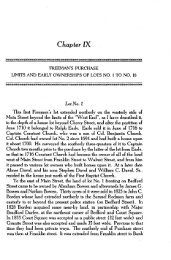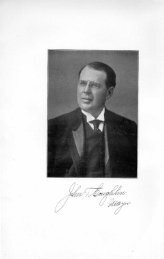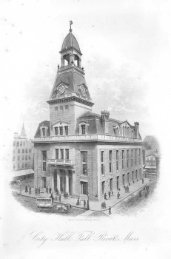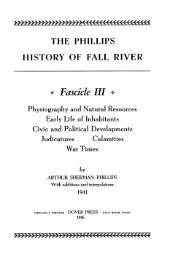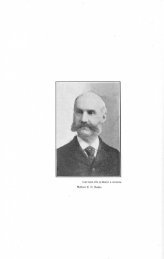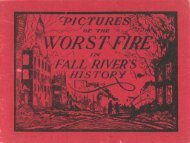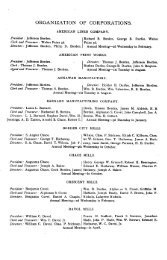Fall Rivers' Industries
Fall Rivers' Industries
Fall Rivers' Industries
You also want an ePaper? Increase the reach of your titles
YUMPU automatically turns print PDFs into web optimized ePapers that Google loves.
proximately $25,500,000, and factories repre -<br />
senting an investment of nearly twice that<br />
sum, with 3,300,000 spindles and 83,00 0<br />
looms, giving employment to 32,500 hands ,<br />
producing more than 1,500 miles of clot h<br />
every working day, as well as a larg e<br />
amount of yarns, thread, quilts and variou s<br />
other cotton products .<br />
The principal facts in regard to each of<br />
the larger corporations, as well as some tha t<br />
have suspended or been merged in others ,<br />
appear below :<br />
The <strong>Fall</strong> River Iron Works, now an im -<br />
mense cotton manufacturing plant, givin g<br />
employment to 4,500 hands, has been intimately<br />
associated with the progress of th e<br />
city .and has played an important part i n<br />
its development. It had its inception i n<br />
1821 in a small shipbuilding business carried<br />
on near the site of the Metacomet mill,<br />
by Bradford Durfee, a shipwright, and Richard<br />
Borden, the owner of a grist mill nearby .<br />
The need of iron work for the vessels and<br />
also the demand for spikes, bars, rods an d<br />
other iron articles for constructive purpose s<br />
suggested the starting of shops for their<br />
manufacture, and a company was forme d<br />
by Richard Borden, Bradford Durfee, Holde r<br />
Borden, David Anthony, William Valentine ,<br />
Joseph Butler and Abram and Isaac Wilkinson,<br />
the last four of Providence . The original<br />
capital was $24,000, but this was soo n<br />
after reduced by the withdrawal of th e<br />
Wilkinsons to $18,000 .<br />
The first shops were on the land now occupied<br />
by the Iron Works No . 6, formerly<br />
the Metacomet mill, and produced hoop iro n<br />
for the New Bedford oil trade. Nail an d<br />
rolling mills were also erected and enlarge d<br />
from time to time, as the business rapidly<br />
developed. By 1876 the company was employing<br />
600 hands. It had meantim e<br />
branched out into other lines, and had bee n<br />
transferred to the present location of th e<br />
main mills of the company. It had been th e<br />
principal promoter of the Anawan mill i n<br />
1825, the Providence line of steamboats commencing<br />
with the Hancock in 1827, followe d<br />
by the King Philip in 1832, Bradford Durfe e<br />
in 1845, Richard Borden in 1874, Canonicu s<br />
and Metacomet ; the <strong>Fall</strong> River Line to Ne w<br />
York in 1847, the gas works and the rail -<br />
road to Myricks, about the same time, an d<br />
the Metacomet mill .<br />
The company had been incorporated i n<br />
1825, with a capital of $200,000, increased i n<br />
1845 to $960,000, though not a dollar ha d<br />
been paid in except for the original invest-<br />
HISTORY OF FALL RIVER<br />
ment of $18,000. No dividends in cash wer e<br />
paid until 1850, but between that time an d<br />
1880 the stockholders received $3,073,000 ,<br />
besides stock in the <strong>Fall</strong> River Manufactory ,<br />
the Troy Cotton & Woolen Co., the America n<br />
Print Works and the Bay State Steamboat<br />
Co . In 1880 it was thought advisable to di -<br />
vide the property and form new corporations,<br />
the Metacomet mill, with $288,00 0<br />
capital, the <strong>Fall</strong> River Machine Co ., $96,000 ;<br />
<strong>Fall</strong> River Gas Works Co ., $288,000, an d<br />
<strong>Fall</strong> River Steamboat Co ., $192,000. For<br />
each share in the old companies three wer e<br />
given in the Metacomet, three in Gas Co . ,<br />
one in the Machine Co., and two in th e<br />
Steamboat Co. This left the old compan y<br />
a large amount of real estate and valuabl e<br />
wharf property, with buildings . Richar d<br />
Borden was clerk, treasurer and agent fro m<br />
1828 to 1874, when he was succeeded b y<br />
Philip D. Borden, and one year later by Robert<br />
C. Brown .<br />
Soon after the division of the propert y<br />
the manufacture of iron was discontinue d<br />
on account of underselling by plants near<br />
the mines, and M . C. D. Borden, who ha d<br />
become the sole owner of the America n<br />
Printing Co. in 1886, shortly after that tim e<br />
also purchased the Iron Works Co., whic h<br />
had a valuable water front adjoining th e<br />
print works. He razed the old buildings ,<br />
and in 1889 began the construction of a<br />
vast cotton manufacturing plant to suppl y<br />
cloth for printing. The first mill was, lik e<br />
those subsequently erected, of brick, an d<br />
was 386x120 feet, four stories in height ,<br />
with a towering chimney 359 feet above th e<br />
ground, the highest in the United States a t<br />
the time. A second mill was built in 1892 ,<br />
three stories high, 575x120, and the following<br />
year No . 3, four stories, 309x142, No. 4 ,<br />
372½2 x165½ , was erected in 1895, and it s<br />
starting on Oct. 17 was made the occasion<br />
of a notable dinner of New York and Fal l<br />
River men on the steamer Priscilla, at which<br />
Mr. Borden announced a gift of $100,000 to<br />
the charities of the city . No. 5 mill wa s<br />
built in 1902, and is 165x372 feet, with a n<br />
ell 30x40. Since 1900 the property has bee n<br />
further increased by the purchase of th e<br />
<strong>Fall</strong> River Machine Co., on which larg e<br />
storehouses were erected, and the Meta -<br />
comet and Anawan mills. The former wa s<br />
enlarged and improved as No . 6 mill, an d<br />
the old Anawan, which had been idle fo r<br />
some years and used as a storehouse, wa s<br />
torn down to make way for No . 7 mill, 142 x<br />
310, three stories in height at the south end




